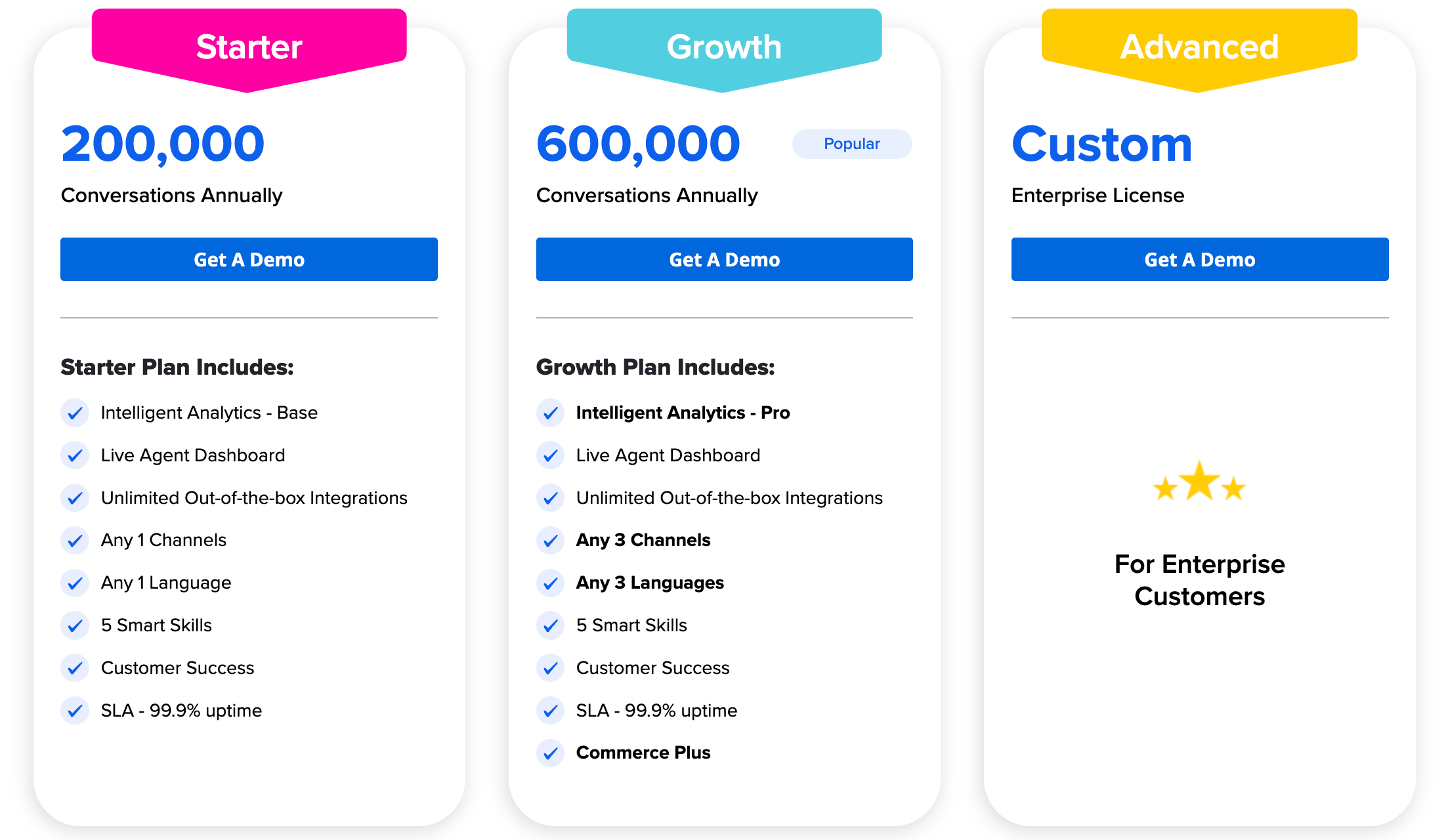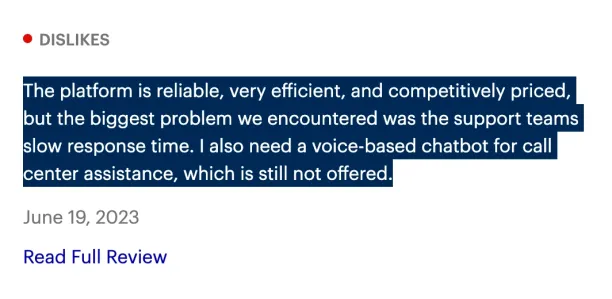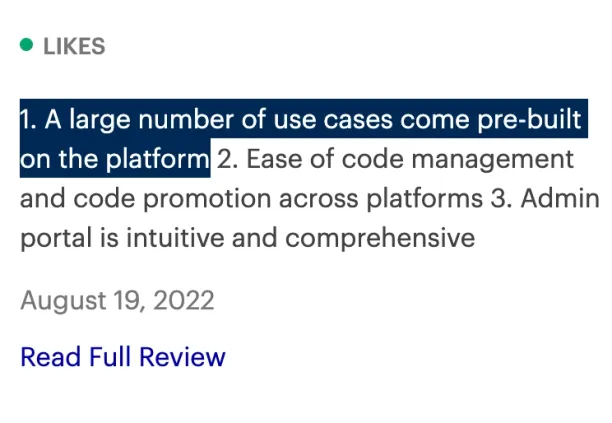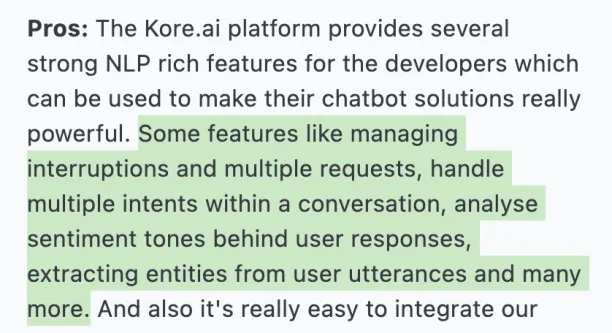Top 3 IBM Watson Competitors Under $2,000 in 2024
A “good” user experience increases conversion KPIs by 80%.
So providing a seamless customer interaction could be one reason behind companies investing in conversational AI platforms. And IBM Watson is one of the widely-used platforms for automating customer service and customer interaction.
However, no tool is perfect. Our research has identified a few negatives users have had with IBM Watson, mainly that it is:
- Too expensive for SMBs
- Data-heavy
- Lacking in analytics
In this article, we will evaluate IBM Watson in more details, and look at 3 alternatives that could be better aligned with your business needs.
IBM Watson Review
To automate customer interactions, IBM Watson offers:
- Advanced deep learning functionalities
- Machine learning
- Natural language processing (NLP) and natural language understanding (NLU)
- Large language models (LLMs)
Based on IBM’s analysis, its conversational AI platform provides a:
- 370% ROI
- 95% response accuracy
- 24/7 reliability
A) Ratings
- AIMultiple: 4.4/5
- Gartner: 4.5/5
- G2: 4.4/5
- Trust Radius: 8.7/10
B) Pricing
| Version | Pricing/month | Features |
|---|---|---|
| Lite | Free | – Handles 1,000 users/month – Offers 3 bots – Stores analytics data for 7 days – Holds a 5-minute timeout |
| Plus | $140 | – Handles +1,000 users/month – Offers 10 bots – Stores analytics data for 30 days – Holds a 24-hour session timeout limit |
| Enterprise | Customized | – Handles +50,000 users/month – Offers 30 bots – Stores analytics data for 90 days – Holds a 7-day session timeout limit |
C) Pros of IBM Watson
- Ease of setup: Bots can be created with little programming knowledge1

- Wide applicability: Besides lifelike conversational interactions, it can execute rule-based tasks2

- Integrability: It can be integrated into different platforms3

D) Cons of IBM Watson
- Data heavy: The tool needs lots of data for model training, not all of which can be easily created4

- Expensive: The cost can add up for large companies that need a scalable solution5

- Lack of analytics: The analytics feature might offer limited insights to business users[/efn_note] Gartner. [/efn_note]

Why look for IBM Watson alternatives?
You should look for IBM Watson alternatives if you
- Find IBM Watson’s pricing to be high
- Want a less data-heavy solution
- Need advanced analytics
We narrowed our search to solutions that matched IBM Watson (i.e. easy to set up, flexible, integrable), but without its shortcomings. Our shortlist for IBM Watson Assistant alternatives is:
- Haptik
- Kore.ai
- Google Dialogflow
| Haptik | Kore.ai | Google Dialogflow | |
|---|---|---|---|
| AIMultiple | 4.4 | N/A | N/A |
| Gartner | 4.4/5 | 4.7/5 | 4.2/5 |
| G2 | 4.5/5 | 4.7/5 | 4.3/5 |
| Trust Radius | N/A | 7.6/10 | 8.1/10 |
Haptik
Haptik’s conversational artificial intelligence software offers highly engaging user experiences across numerous industries, and is integratable with:
- Webchat, and more.
Haptik offers:
- Prebuilt conversation workflows
- NLP for automatic speech recognition
- AI-powered live agent assistants for lifelike conversational interactions
- Multilingual assistants
- Campaign bots
- No-code setup
- User dashboard for predictive analysis and predictive analytics
Pricing
Haptik’s 3-tier pricing starts at $416/month. It seems to be more expensive than IBM Watson, but offers 16,000 conversations/month.

Pros of Haptik
- Analytics dashboard: The analytics dashboard offers business insights, usable by data scientists to fine-tune the chatbot6

- Simple setup: Haptik’s no-code engine enables a quick and simple setup7

- Data-efficient: Users haven’t labelled Haptik as “data-hungry.” It can be run with an “efficient” amount of data fed into it8

Cons of Haptik
- Sporadic misunderstandings: The automatic speech recognition feature can sometimes malfunction9

- Slow response time: The support response can periodically be slow10

- Lack of integration: Haptik’s chatbot can sometimes not integrate well with other products, like WhatsApp11

Kore.ai
Kore.ai is another one of IBM Watson’s top alternatives. Their chatbot and virtual assistants are powered by a no-code, flexible architecture usable by citizen developers and professional programmers alike.
Pricing
Kore.ai has a Standard (conversation-based) and an Enterprise (session-based) plan.
The Standard plan costs $0.2/session, chargeable at $100 intervals, equalling 500 conversations. The Enterprise plan, on the other hand, has customized pricing model.
Pros of Kore.ai
- Data-efficient: Kore.ai can be set up and utilized across multitude of use cases with a small amount of training data12, 13


- Detailed documentation: The trainings and documentation are detailed and easy to learn for users 14

- Analytical dashboard: Kore.ai’s dashboard offers detailed data, including the analysis of user sentiment15, 16


Cons of Kore.ai
- Confused self-service: The chatbot doesn’t work well autonomously. It needs a human-in-the-loop17

- No integration with external databases: Kore.ai doesn’t connect with external databases for retrieving information18

- Too many updates: Chatbot receives too many updates, making retrieval of older versions impossible19

Google Cloud Dialogflow
Google Dialogflow can be used to create chatbots, voice assistants, and virtual assistants, all of which can be integrated with different conversational platforms, such as:
- Google Assistant
- Slack
- Telegram
Data scientists can use its no-code interface for:
- Model training
- Designing conversation flows
- Defining intents
Pricing
Google Dialogflow comes in 2 packages, CX agent and ES agent. CX is usable for large companies, ES for small ones.
CX agent costs $0.007 per text request, the ES agent $0.002. Therefore, to run 16,000 requests/month (the same amount as Haptik offers in their base package), it costs:
- $384 annually for the ES agent
- $1344 annually for the CX agent
Pros of Dialogflow
- No-code: Same as other chatbots on our list, Google Dialogflow’s no-code base simplifies bot set up20

- Easy to train: Training the chatbot can be straightforward, whereby the generative AI uses the input to create the replies21

- Analytics: The visible dashboard provides detailed insights and analytics which helps with the unsupervised running of the bot22

Cons of Dialogflow
- Lack of documentation: Documentation, especially Python-related ones, can be deficient23

- Limited customizability: Customization can be limited, often dragged down by the no-code framework24

- Limited keyword breadth: There’s too much reliance on exact keywords, and a weak NLP engine25

For more on chatbots
To learn more about chatbots, read:
- Top 3 Yellow.ai Competitors & Alternatives Detailed Guide
- MSP ChatGPT: Leveraging Conversational AI to Drive Success
- 10 Use Cases of Conversational AI for Customer Service
Transparency Statement:
AIMultiple collaborates with many technology vendors including Haptik.
Sources
External Links

Cem is the principal analyst at AIMultiple since 2017. AIMultiple informs hundreds of thousands of businesses (as per Similarweb) including 60% of Fortune 500 every month.
Cem's work has been cited by leading global publications including Business Insider, Forbes, Washington Post, global firms like Deloitte, HPE, NGOs like World Economic Forum and supranational organizations like European Commission. You can see more reputable companies and media that referenced AIMultiple.
Throughout his career, Cem served as a tech consultant, tech buyer and tech entrepreneur. He advised enterprises on their technology decisions at McKinsey & Company and Altman Solon for more than a decade. He also published a McKinsey report on digitalization.
He led technology strategy and procurement of a telco while reporting to the CEO. He has also led commercial growth of deep tech company Hypatos that reached a 7 digit annual recurring revenue and a 9 digit valuation from 0 within 2 years. Cem's work in Hypatos was covered by leading technology publications like TechCrunch and Business Insider.
Cem regularly speaks at international technology conferences. He graduated from Bogazici University as a computer engineer and holds an MBA from Columbia Business School.
Sources:
AIMultiple.com Traffic Analytics, Ranking & Audience, Similarweb.
Why Microsoft, IBM, and Google Are Ramping up Efforts on AI Ethics, Business Insider.
Microsoft invests $1 billion in OpenAI to pursue artificial intelligence that’s smarter than we are, Washington Post.
Data management barriers to AI success, Deloitte.
Empowering AI Leadership: AI C-Suite Toolkit, World Economic Forum.
Science, Research and Innovation Performance of the EU, European Commission.
Public-sector digitization: The trillion-dollar challenge, McKinsey & Company.
Hypatos gets $11.8M for a deep learning approach to document processing, TechCrunch.
We got an exclusive look at the pitch deck AI startup Hypatos used to raise $11 million, Business Insider.
To stay up-to-date on B2B tech & accelerate your enterprise:
Follow on
Comments
Your email address will not be published. All fields are required.